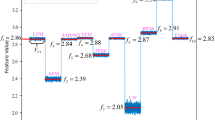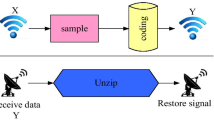Abstract
In this paper, a novel recognition method based on the squeeze-and-excitation networks (SE-Nets) is proposed in order to recognize intra-pulse modulation signals at varying noise levels automatically. Firstly, different signal transforms including time domain, frequency domain and time–frequency domain are used to convert seven different intra-pulse modulation signals into images. Then, since the SE-Net has great advantages in image processing, the images are classified by the squeeze-and-excitation networks and output the results in each domain. Lastly, the decisions of different domains are combined to obtain the final results. The simulation results demonstrate that the recognition accuracies are all more than 95% except BPSK signals which are still more than 90% at the case of − 8 dB. Compared with several other neural networks and traditional support vector machine method, the accuracy of SE-Net method has increased more than 2% and performs better under different SNR conditions. The measured signals results show that the accuracies of the SE-Net method are higher than those of several other neural networks, especially for BASK and BFSK signals.












Similar content being viewed by others
References
Li, Z.: A review of several foreign radar reconnaissance equipment. Shipboard Electr. Countermeasure 4, 5–10 (1999)
Wu, Z., Wang, Y., Cai, Y.: Tactical operation for electronic warfare reconnaissance in complex electromagnetic environment. Electr. Inf. Warf. Technol. 28(4), 28–29 (2013)
Yang, L. B. , S. S. Zhang , B. Xiao: Radar emitter signal recognition based on time-frequency analysis. In: IET International Radar Conference 2013. IET, Xi’an (2013). https://doi.org/10.1049/cp.2013.0335
Yan, M., Wang, L.: Weighted Kalman filter phase unwrapping algorithm based on inSAR image. Eng. Rev. 3, 227–231 (2013)
Ma, F., Zhang, X.: Wideband DOA estimation based on focusing signal subspace. SIViP 13(4), 675–682 (2019)
Setayesh, A., Yazdian, E., Malek-Mohammadi, M.: Direction of arrival estimation with missing data via matrix completion. Signal Image Video Process. 13(7), 1451–1459 (2019)
Zhang, G., Huang, K., Wen-li, J.: Emitter feature extract method based on signal envelope. J. Syst. Eng. Electr. 294, 795–797 (2006)
Misans, P., Terauds, M.: CW doppler radar based land vehicle speed measurement algorithm using zero crossing and least squares method. In: 13th Biennial Baltic Electronics Conference, pp. 161–164 (2012)
Wang, S., Zhang, D., Bi, D., et al.: Research on recognizing the radar signal using bispectrum cascade feature. J. Xidian Univ. 39(2), 127–132 (2012)
Teng, X., Tian, P., Yu, H.: Modulation classification based on spectral correlation and SVM. In: 4th International Conference on Wireless Communications, Networking and Mobile Computing, pp. 1–4 (2008)
Li, Y., Wang, Y., Yun, L.: Recognition of radar signals modulation based on short time Fourier transform and reduced fractional Fourier transform. J. Inf. Comput. Sci. 10(16), 5171–5178 (2006)
Hinton, G.E., Osindero, S., Teh, Y.-W.: A fast learning algorithm for deep belief nets. Neural Comput. 18(7), 1527–1554 (2006)
Salakhutdinov, R., Hinton, G. E.: Deep Boltzmann machines. In: Proceedings of the 12th International Conference on Artificial Intelligence and Statistics, pp. 448–455 (2009)
Sahiner, B., Chan, H.P., Petrick, N., et al.: Classification of mass and normal breast tissue: a convolution neural network classifier with spatial domain and texture images. IEEE Trans. Med. Imaging 15(5), 598–610 (1996)
Guo, L., Chen, X., CHEN, T.: Radar signal modulation type recognition based on AlexNet module. J. Jilin Univ. (Eng. Technol. Ed.) 19(03), 1000–1008 (2019)
Chen, C., Jin, W., Zhang, W.: Application of improved DNN algorithm in radar signal sorting. Appl. Res. Comput. 36(04), 1178-1180+1185 (2019)
Zhou, D., Wang, X., Tian, Y., Wang, R.: A novel radar signal recognition method based on a deep restricted Boltzmann machine. Eng. Rev. 37(2), 165–171 (2017)
Chu, C., Xu, H., Zhou, Y.: A novel algorithm for estimating pulse repetition frequency. Electr. Inf. Warfare Technol. 2, 18–22 (2007)
An, Z., Li, Y.: Performance analysis of PRI Transform in the radar pulse signal PRI detection. Mod. Radar 2, 35–37 (2007)
Li, H., Cheng, Y., Dai, W., Li, Z.: A method based on wavelet packets-fractal and SVM for underwater acoustic signals recognition. In: 12th International Conference on Signal Processing (ICSP), pp. 2169–2173 (2014)
Hu, J., Li, S., Gang, S.: Squeeze-and-excitation networks. In: Proceedings of the IEEE conference on computer vision and pattern recognition, pp. 7132–7141 (2018)
Robbins, H., Monro, S.: A stochastic approximation method. Ann. Math. Stat. 400–407 (1951)
Krizhevsky, A., Sutskever, I., Hinton, G.E.: Imagenet classification with deep convolutional neural networks. Advances in Neural Information Processing Systems, pp. 1097–1105, (2012)
He, K., Zhang, X., Ren, S., Sun, J.: Deep residual learning for image recognition. Proceedings of the IEEE Conference on Computer Vision and Pattern Recognition, pp. 770–778 (2016)
Simonyan, K., Zisserman, A.: Very deep convolutional networks for large-scale image recognition. arXiv preprint arXiv:1409.1556 (2014)
Acknowledgements
This work was supported by the CEMEE Laboratory-Funded Project (No. CEMEE2019Z0102B) and the National Natural Science Foundation of China (No. 61501098).
Author information
Authors and Affiliations
Corresponding author
Additional information
Publisher's Note
Springer Nature remains neutral with regard to jurisdictional claims in published maps and institutional affiliations.
Rights and permissions
About this article
Cite this article
Wei, S., Qu, Q., Su, H. et al. Intra-pulse modulation radar signal recognition based on Squeeze-and-Excitation networks. SIViP 14, 1133–1141 (2020). https://doi.org/10.1007/s11760-020-01652-0
Received:
Revised:
Accepted:
Published:
Issue Date:
DOI: https://doi.org/10.1007/s11760-020-01652-0




